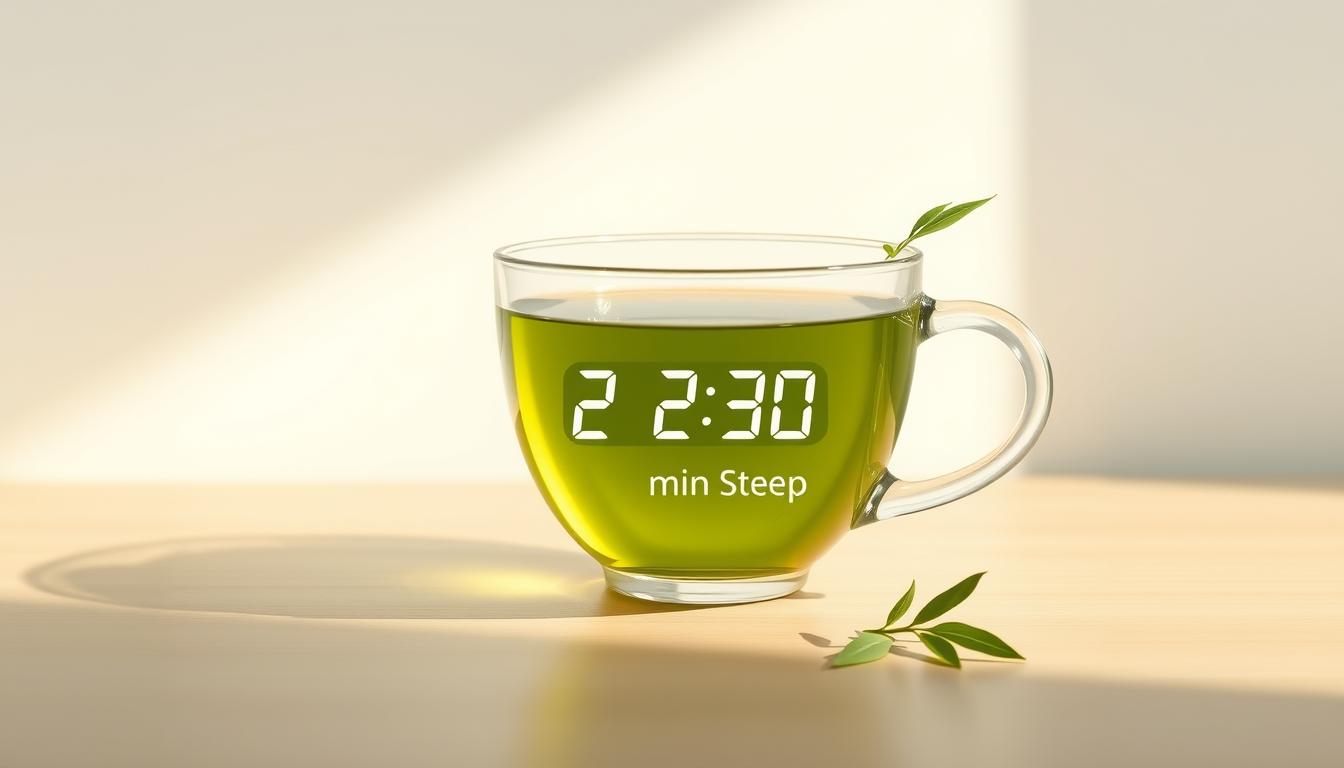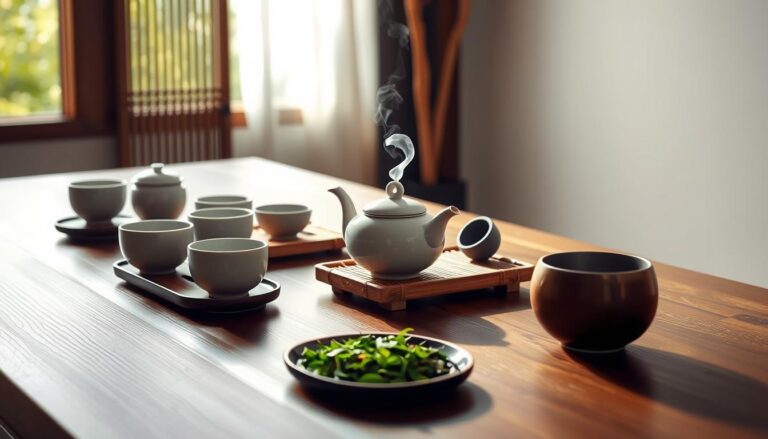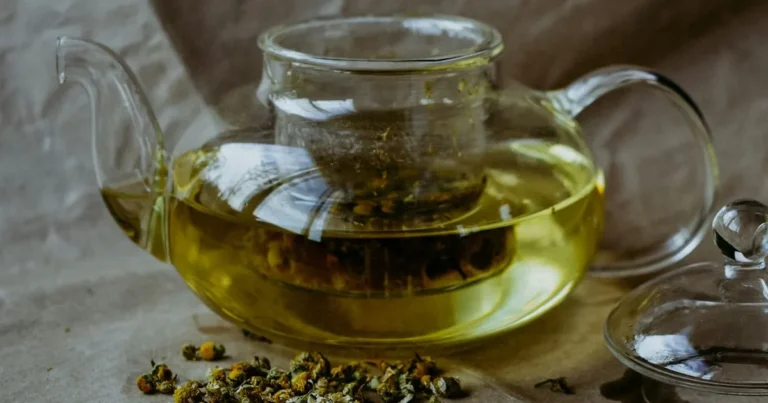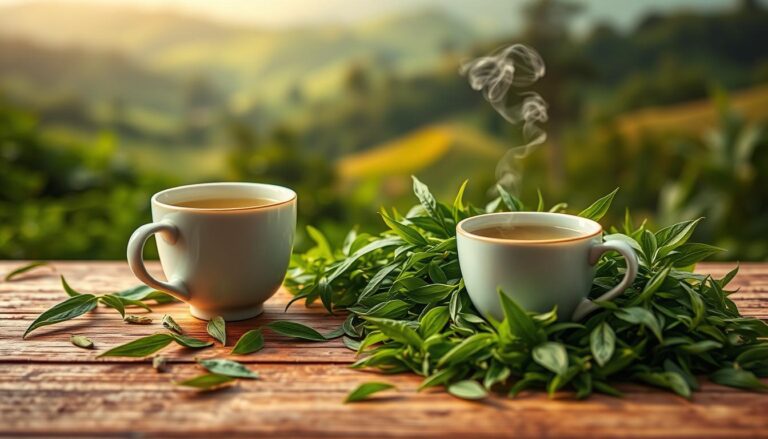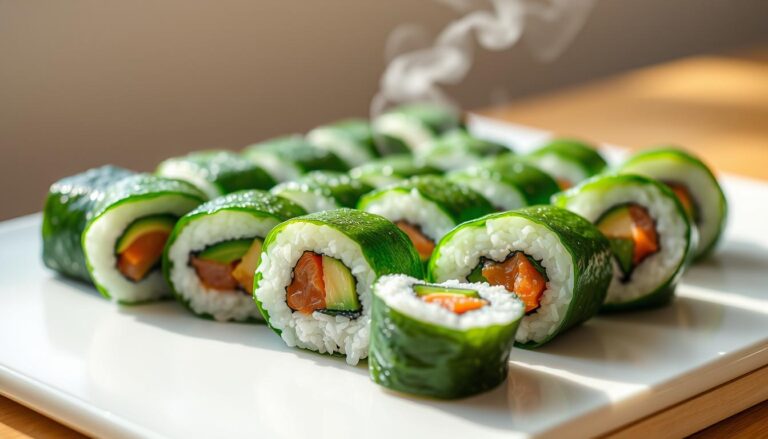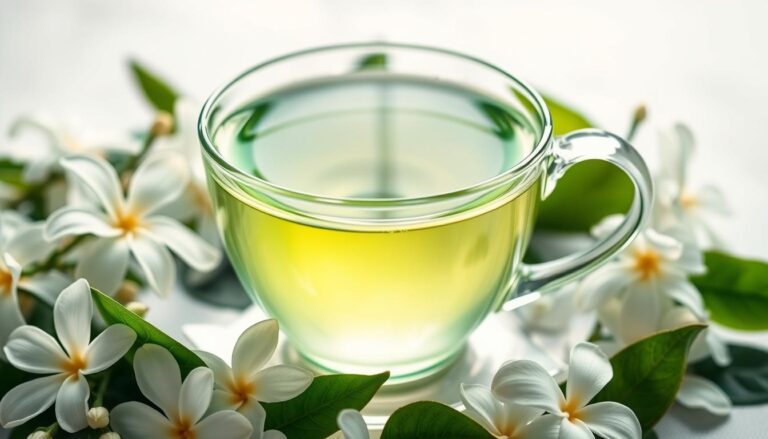How Long to Steep Green Tea: Find the Optimal Time
Wondering How Long to Steep Green Tea? Getting the timing right is the secret to a perfect cup—rich in flavor and full of health benefits. Steep too briefly, and you miss out on its goodness; steep too long, and bitterness takes over. Master the ideal steeping time to enjoy green tea at its best.
Table of Contents
Understanding Green Tea Varieties
Green tea comes in over 1,500 types, each with its own taste and steeping time. Every type is shaped by how it’s made, where it’s from, and the tea plants used. This makes green tea a world of flavors waiting to be discovered.
Popular Green Tea Types
Some famous green teas include Japanese Matcha, Sencha, and Gyokuro, and Chinese Dragonwell and Gunpowder. Each has its own taste and how it should be steeped.
- Matcha: Known for its powdered form and rich, umami flavor.
- Sencha: A popular Japanese green tea with a light, refreshing taste.
- Gyokuro: A high-quality, shade-grown Japanese tea with a complex flavor profile.
- Dragonwell: A Chinese green tea known for its flat, pan-fried leaves and delicate taste.
- Gunpowder: A Chinese tea with leaves rolled into small pellets, offering a light, slightly smoky flavor.
Flavor Profiles of Different Greens
Green teas can taste very different. Some, like Japanese Sencha, have grassy notes. Others, like Chinese Dragonwell, have nutty and floral hints. Knowing these flavors helps you pick the right tea for you.
Some teas taste vegetal or grassy. Others have floral, fruity, or nutty flavors. Steeping time also changes the taste, with longer times making it more bitter.
Trying different green teas and steeping times can be fun. It lets you find the best way to enjoy your favorite tea.
Factors Affecting Steeping Time
To brew the perfect cup of green tea, you need to consider several factors that affect steeping time. The ideal steeping time can vary significantly based on a few key elements.
Water Temperature Considerations
The temperature of the water used for steeping green tea is very important. For example, Japanese green teas like Sencha and Gyokuro need cooler water than Chinese green teas. If the water is too hot, it can make the tea taste bitter. If it’s too cold, it won’t bring out the tea’s full flavor.
Tea Leaf Size and Shape
The size and shape of the tea leaves also affect steeping time. Larger or more tightly rolled leaves need longer to unfurl and release their flavors. Smaller or more loosely rolled leaves steep faster.
Freshness of Tea Leaves
The freshness of the tea leaves is also key. Fresh tea leaves have more vibrant flavors and aromas, steeping faster than older leaves. Using high-quality, fresh tea leaves can greatly improve your tea’s taste.
By understanding and adjusting these factors, you can tailor your green tea brewing technique to suit your personal preferences. This way, you can enjoy the perfect cup every time.
General Steeping Guidelines
Mastering the art of steeping green tea is key. You must know the right steps to brew a perfect cup. This involves understanding the factors that affect the steeping process.
Steeping green tea is more than just adding tea leaves to hot water. It’s about finding the right balance between flavor and health benefits.
Recommended Time for Steeping
The steeping time for green tea ranges from 1-3 minutes. This depends on the tea type and your taste. For example, Japanese Sencha needs about 1 minute, while Chinese Gunpowder might take 2-3 minutes.
You can adjust the steeping time to suit your taste. For a stronger tea, steep it longer. But be careful not to steep too long, as it can become bitter.
Here are some general guidelines for steeping times:
- Delicate green teas: 1-2 minutes
- Standard green teas: 2-3 minutes
- Stronger green teas: 3 minutes
Importance of Water Quality
High-quality water is crucial for a perfect green tea. The tea’s taste is greatly influenced by the water. So, use fresh, filtered water without impurities.
Filtered water enhances the green tea’s flavors. Unfiltered water might add unwanted tastes or smells. Use a water filter or a filtered water bottle for the best taste.
By following these guidelines, you can enjoy a delicious and healthy cup of green tea.
How to Steep Loose Leaf Green Tea
To make the perfect cup of loose leaf green tea, you need to know the basics of steeping. This type of tea has a more complex taste than tea bags. It’s worth the extra effort for those who love tea.
Equipment You’ll Need
Steeping loose leaf green tea needs a few simple tools. You’ll need a tea infuser or strainer, a ceramic cup or teapot, and a thermometer. The thermometer is key for the right water temperature.
- A tea infuser or strainer lets the leaves unfurl and release their flavors.
- A ceramic cup or teapot is best because it doesn’t add any bad flavors to the tea.
- A thermometer is crucial for the right water temperature, which is between 160°F and 170°F for green tea.
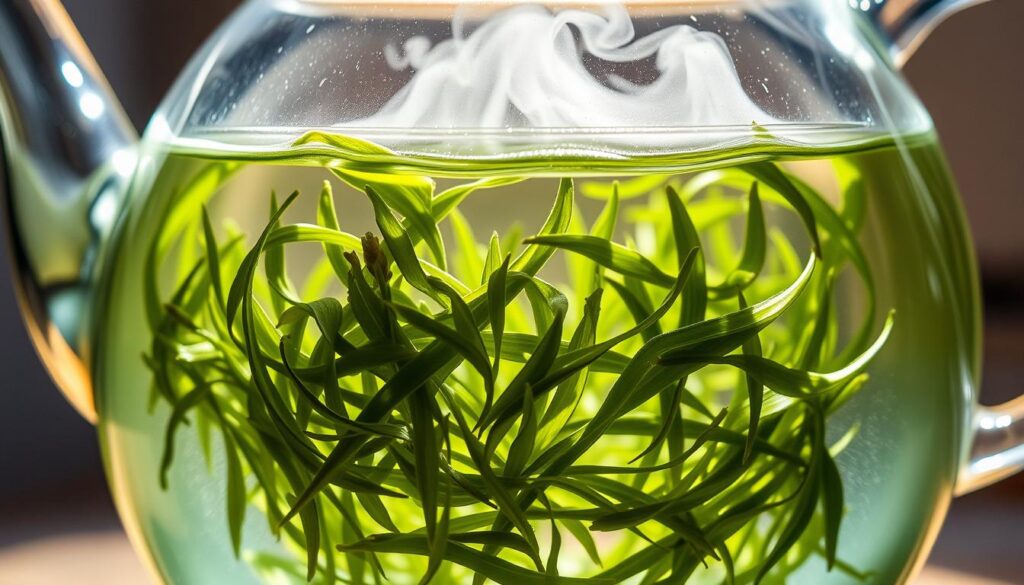

Step-by-Step Brewing Process
Brewing loose leaf green tea is easy with the right tools. Here’s how to do it:
- Measure the tea leaves: Use about 1 teaspoon of loose leaf green tea per 8 oz of water. Adjust to taste.
- Heat the water: Use fresh, filtered water and heat it to the optimal temperature for green tea, typically between 160°F and 170°F.
- Steep the tea: Put the measured tea leaves in the infuser or directly into the teapot. Pour the heated water over the leaves and let it steep for 1-3 minutes. The time depends on the type of green tea and your taste.
- Serve: After the steeping time, remove the infuser or strain the tea into your cup. You can enjoy it as is or with honey or lemon.
By following these steps and using the right equipment, you can enjoy a perfectly brewed cup of loose leaf green tea. It will show off its unique flavors and aromas.
How long to Steep Green Tea Bags
Green tea bags make it easy to enjoy this healthy drink. But, steeping them right is crucial.
The quality of the tea bags and how you steep them can change the taste and health benefits of your green tea.
Choosing the Right Tea Bags
When picking green tea bags, look for those with high-quality tea leaves. They should be free from artificial additives and preservatives.
Consider these factors:
- The type of green tea used (e.g., Sencha, Matcha, or Jasmine)
- The material of the tea bag (some are biodegradable or made from natural fibers)
- The brand’s reputation and customer reviews
Brewing Instructions for Convenience
Steeping green tea bags is easy. Just pay attention to a few important details.
Follow these steps:
- Heat water to the right temperature (around 160°F to 170°F).
- Put one tea bag in a cup or teapot.
- Pour the hot water over the tea bag.
- Let the tea steep for 1 to 3 minutes, depending on how strong you like it.
- Take out the tea bag and enjoy your tea.
You can change the steeping time to suit your taste. Just follow the instructions on your green tea bags.
Signs of Oversteeping Green Tea
Finding the right steeping time is key to a perfect cup of green tea. Steeping it for too long can make it unpleasant.
Oversteeping green tea can make it taste bad and lose its health benefits. This is because it releases too many compounds.
Bitter Flavors to Look Out For
One sign of oversteeping green tea is bitter flavors. Green tea is usually light and tasty. But, steeping it too long can make it bitter.
Key indicators of bitter flavors include:
- A sharp, astringent taste
- A flavor that lingers unpleasantly
- A loss of the tea’s natural sweetness
To avoid bitter flavors, watch the steeping time. Adjust it to your liking.
Color and Aroma Changes
Oversteeping green tea also changes its color and aroma. Green tea is usually light and has a refreshing smell.
Signs of oversteeping in color and aroma include:
| Characteristic | Normal Steeping | Oversteeping |
|---|---|---|
| Color | Light green or pale yellow | Darker yellow or brownish |
| Aroma | Subtle, grassy, or floral | Strong, bitter, or unpleasant |
Knowing these changes helps you adjust the steeping time. This way, you can enjoy a balanced and tasty cup of green tea.
Health Benefits of Properly Steeped Green Tea
Steeping green tea right unlocks many health benefits. Green tea has been valued for centuries for its health benefits. Steeping it correctly is key to getting these benefits.
Steeping green tea is more than just making a drink. It’s about getting the good stuff that helps your health.
Antioxidant Properties Explained
One big health benefit of steeped green tea is its antioxidants. Antioxidants protect the body from free radicals. Free radicals can cause diseases like cancer and heart disease.
Catechins, especially EGCG, are strong antioxidants. They might help lower cancer and heart disease risks. The steeping time affects how much catechins get into the tea.
| Antioxidant | Benefits | Optimal Steeping Time |
|---|---|---|
| Catechins | Anti-cancer properties, cardiovascular health | 1-3 minutes |
| EGCG | Anti-inflammatory, anti-cancer properties | 2-3 minutes |
| Other Polyphenols | Antioxidant effects, overall health | 1-2 minutes |
Boosting Metabolism and Well-Being
Steeped green tea also boosts metabolism and well-being. It has caffeine, which helps you feel alert and can aid in weight loss. It also has L-theanine, which helps you relax and feel less stressed.
Knowing the health benefits of steeped green tea helps you use it wisely. It’s great for antioxidants, metabolism, or just relaxing. Green tea can be a great part of your daily life.
Tips for Enhancing Your Green Tea Experience
Make your daily green tea time more exciting by trying new flavors and foods. It’s all about experimenting to find what you like best.
Flavor Additions to Consider
Adding flavors can make your green tea even better. Try a slice of lemon or a few mint leaves for a refreshing taste. For a sweeter tea, a little honey is perfect.
Spices like ginger or cinnamon can also change your green tea experience. Start with a small amount to not overpower the tea’s taste. This way, you can adjust to your liking.
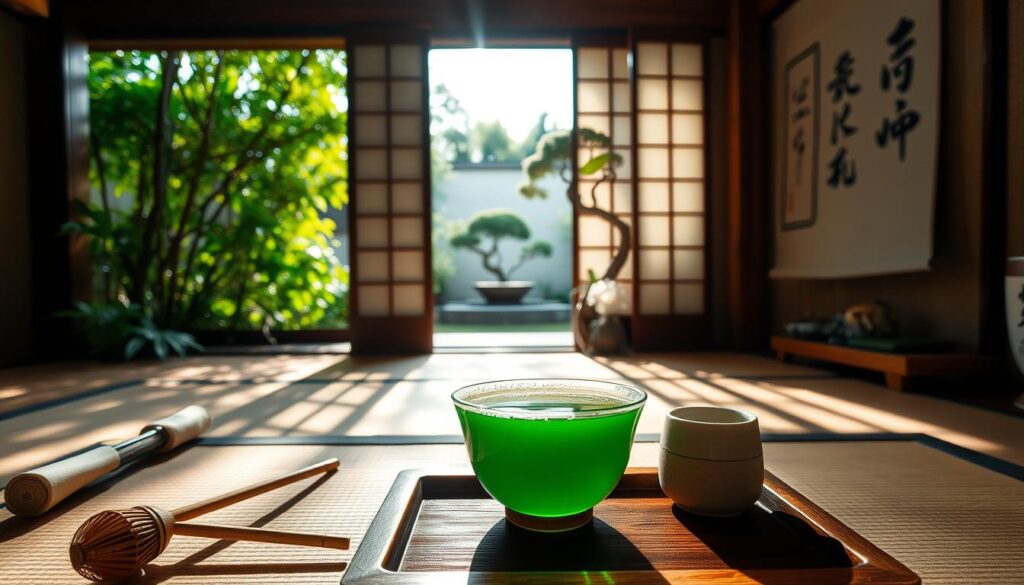

Pairing Green Tea with Food
Drinking green tea with food can make it even more enjoyable. It goes well with many dishes, from salads to grilled meats. For example, a floral green tea pairs well with fruit salads, while a robust one goes with grilled chicken or fish.
Think about the flavors of both the tea and the food when pairing. A delicate green tea can get lost with strong flavors. Start with mild pairings and adjust as needed.
By following these tips, you can make your green tea time even better. Whether it’s with new flavors or food pairings, there’s always something new to try.
Conclusion: Perfecting Your Green Tea Steeping Routine
Learning to steep green tea is a journey of patience and trial. You’ve discovered that the type of tea, water temperature, and steeping time are key. These elements help bring out the best flavor and health benefits of green tea.
Discovering Your Ideal Steep
To find your perfect cup, try adjusting the steeping time. See how it changes the taste. Some like a strong brew, while others prefer a light one. By experimenting, you’ll find your ideal balance.
Exploring Techniques for Enhanced Flavor
Once you’ve found your perfect steep time, try new ways to enhance your tea. Whether using loose-leaf or tea bags, understanding your tea variety is crucial. Be open to trying new methods to perfect your green tea.

